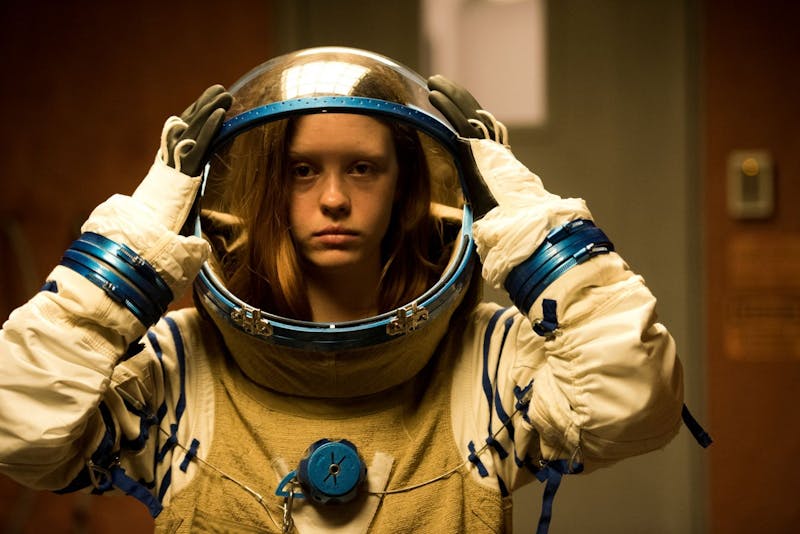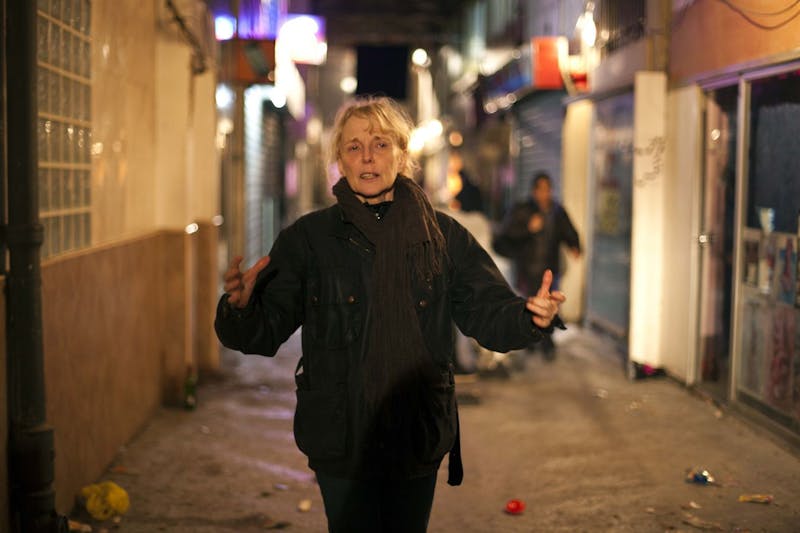Critics use the adjective “elliptical” a lot for Claire Denis’s movies. From a Greek word meaning “to fall short,” ellipses are the dot dot dot indicating a word left out from a sentence. The elliptical filmmaker is one who leaves things out. From her first feature Chocolat (1988) to her new movie High Life, the 73-year-old Denis has made films with enormous holes in them, in order to draw attention to what is left behind.
High Life is Denis’s first movie in English, packed with bona fide stars: André Benjamin (alias André 3000), Robert Pattinson, Mia Goth, Juliette Binoche. In synopsis, it sounds like a fairly straightforward sci-fi offering. A group of death-row felons hurtle through space toward a black hole, ostensibly for the purposes of harvesting its energy. The catch is that they must cooperate with sexual experiments performed on them by the ship’s doctor, herself also a criminal.
But High Life is no blockbuster space romp. It is a slow-paced, speculative flick working within the rich tradition that began with Stanley Kubrick’s 2001: A Space Odyssey (1968) and was cemented in Andrei Tarkovsky’s great philosophical achievement, 1972’s Solaris. Like those films, Denis’s new picture begins ambiguously—a wet gourd in a garden, a shoe nearby—before unfurling a psychological drama that never lets you forget the cruel void just outside the spaceship window.

The wet gourd, we learn, is growing in a special room on the ship dedicated to earth’s flora. In the movie’s beginning, the only remaining passengers are Monte (Pattinson) and his baby daughter. Everybody else is dead. He cares for her sweetly, the camera lingering on the baby’s fat wrists, Pattinson’s rock-hewn face. The only things left on this ship are love and the memory of death.
The rest of the movie plays out in disturbing and nonlinear flashback, showing us impressionistic details from earth (a dog, a friend, a train) and scenes from the ship when it was full of people. The criminals are young, attractive people, of a mix of ethnicities. They wear uniforms and sleep in bunks. Over them Dr. Dibs (Binoche) wields total control. She drugs them to wake and to sleep. She has the male inmates give her their sperm, which she injects into the female inmates in the hope of producing a fetus for her futuristic incubator (her “plastic pussy,” according to one character). She also violates the inmates while they sleep, and plays with their lives uncaringly. The first character to die, for example, does so in childbirth.
As Monte dandles his baby (whom we later find out was conceived without his consent or knowledge), he whispers life lessons to her, like not to eat her own shit. “It’s called a taboo,” he says, turning the word into a crooned lullaby—“taboooo, tabooo.” He is all she has, and he must teach her every one of human society’s edicts. “Break the laws of nature and you’ll pay for it,” he tells her.
Each criminal broke a taboo while on earth. Dr. Dibs, we learn early, killed her own children, though the others’ crimes remain mysteries or near-mysteries. On the ship, the human beings fight to preserve the taboos they have left. “We invented rituals; hygiene first,” Monte says in voiceover as he shaves. The inmates drink recycled water by dividing black water from gray water, a real-life DIY purification system that separates out contamination, the same way prisons act on our societies.
But traditional taboos come under great strain on the spaceship. The crew has been provided with a weird room for sexual activity, for example, where Dr. Dibs cavorts with wild and demonic energy (another character calls her the “shaman of sperm”). The men commit sexual violence against the women, and it’s bloody and horrible: Eyes are stabbed, noses broken. While the men wrestle with their impulses, Dr. Dibs performs her own rape, sedating Monte and “extracting” his sperm while he sleeps. There’s no pacifying human nature.
Rape, sewage, prison, violence, scars on the belly: High Life is a film about the aspects of existence that we keep hidden, because if they were not repressed they might take over the world. But are those natural laws, or man-made limits? Contra Monte, Denis seems to argue the latter. Monte is on death row, but his tenderness as a father and generally moral behavior supplant that fact in our imagination. What should we believe: The law, or our eyes? Nature remains a strong force in High Life, however, generally manifesting as a call to suicide, heard by sinners who have been thrust out of the world and have therefore violated those “laws of nature.” Boyse (Goth) explodes by “spaghettification,” a physics term for a phenomenon that takes place near black holes. Tcherny (Benjamin) buries himself in the garden’s earth.
Denis is almost parodically auteurist, the kind of media-unfriendly filmmaker who enjoys universal acclaim from film enthusiasts and little in the way of ordinary fame. She grew up in Cameroon, and colonialism and racism are high on her list of thematic subjects.
The Denis canon is full of meandering and unpleasant movies, the kind that ask if you are capable of sitting with discomfort in order to access higher truths. In Beau Travail (1999), she invites us to watch a group of bored Legionnaires stationed in Djibouti as they pass their time performing gorgeous, dull, riveting physical exercises together. Bastards (2013) features an impossible-to-follow mystery involving a young girl whose vagina has been brutalized by a corn cob. In Trouble Every Day (2001), she fools us into sympathy with two innocent-looking lead actresses, before one of them merrily rips the flesh from a man’s neck with her teeth.

Just as High Life’s ship is commanded by an infanticidal mother-scientist, Denis’s movies proliferate with characters who confound their own type: a grandfather turned rapist, a soldier turned dancer. She identifies invisible boundaries, the kind we hardly notice, and then hacks at them. Masculinity versus femininity; bloodlines against friendship; caress and injury. The line between fighting and fucking is a Denis favorite: When two people kiss, they are as likely to tear off each other’s lips as to fall in love.
Genital injury is a recurring Denis theme, as are beautiful men who act as muses. Pattinson is only her latest leading man, following Denis Lavant, Vincent Gallo, Vincent Lindon, and more. She uses their oblique and angular beauty in a way that is both erotic and coercive. It’s rare to feel a woman director control her men in this way, and it helps Denis to destabilize her audience’s social training, to cleanse us of assumptions. Romance and gender and violence will not behave in the way you expect, in a Denis movie, because her sexual gaze is like nothing else you’ve seen before. Her eroticism dwells in the crook of an elbow, a pulse seen in a bicep; never in language or simple romance.
High Life will send you back out into the world with a totally new idea of what black holes symbolize. It is an elliptical film, yes, because it will answer only the questions that you did not think to ask. How might a child killer cope with the chance to create new life? What does it mean to be buried in earth, but in space? These are existential questions, but so unfamiliar that Denis could have borrowed them from some different species living on a different planet.
Break the laws of nature and you will pay, Monte says. Break the rules of cinema, Denis retorts, and you might start to uncover things you didn’t even realize you were keeping secret.